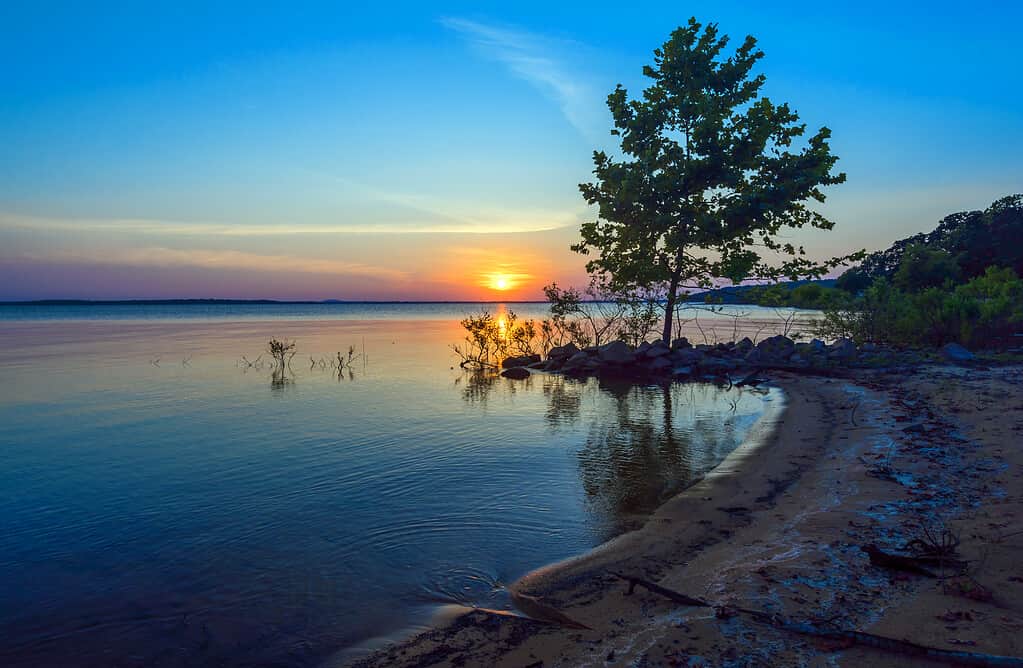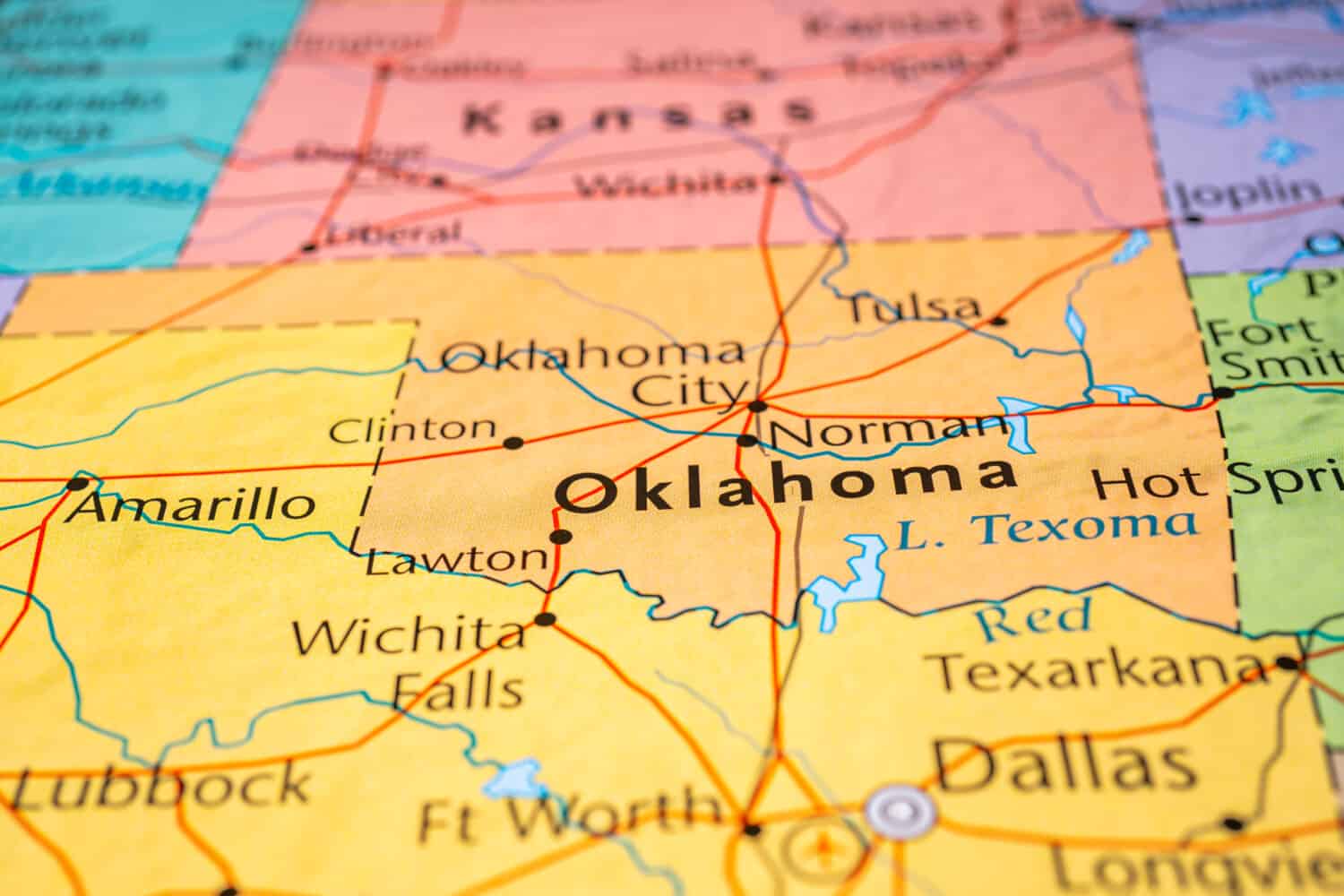Oklahoma sits at an exciting junction of the United States, almost within the exact center of the country. As the 20th largest state by area within the United States, Oklahoma isn’t exactly the largest member of the union. However, it should win an award for its curious panhandle shape! This hub of culture and hardworking heritage is a spot that road-trippers won’t want to miss out on. After all, it’s along the famous Route 66. Please join in as we explore the different aspects of this South-Central gem – perhaps you’ll learn something you never knew about it before!
Where Is Oklahoma Located on the Map?
The state of Oklahoma lies along the gradient of the forested eastern side of the United States and the Great Plains. As such, the state enjoys a central location with an amazing blend of geological features, weather, and wildlife. The approximate coordinates of Oklahoma are 35.5° N latitude and 97.5° W longitude, which sees it as a bridge between the American Midwest, Southwest, and Southern regions. As one might imagine, the state has historically been a byway of cross-country commerce, transportation, and culture, and still continues to be to this day.
Which States Border Oklahoma?
The curiously shaped state of Oklahoma touches borders with a grand total of six states. Firstly, Texas shares the most state lines as it follows both the south and west boundaries for 540 miles. Conversely, nearby Colorado to the northwest has the shortest bordering space at a mere 27 miles.
Kansas can be found to the north, sharing a border for nearly 230 miles. Arkansas has its border to the east for around 190 miles. Missouri lies off to the northeast but only for a short distance of 40 miles. Lastly, New Mexico can be found to the west but only for a brief 31 miles.
When Did Oklahoma Officially Join the U.S.?

Oklahoma was historically two territories, with Oklahoma Territory on the left and Indian Territory on the right.
©United States, Bureau Of The Census, via Wikimedia Commons / Public Domain – Original / License
The area known as Oklahoma State today was originally divided into two separate territories: Indian and Oklahoma. The Oklahoma Territory was designated for settlers to homestead, whereas the Indian Territory was set aside for Indigenous peoples. Although expansion into the Indian Territory became a subject of heated debate, both regions saw rapid growth and development.
Eventually, the prosperous combination of European homesteaders and Native Americans aligned their interests in desiring statehood. This shared desire greatly assisted in repairing relations with both parties, as the indigenous populations had been previously mistreated. You could say that collaborating on the creation of Oklahoma was a unifying event that still resonates to this day.
Therefore, on November 16, 1907, President of the United States Theodore Roosevelt issued a very special proclamation. This issuance, Presidential Proclamation 780, admitted Oklahoma as the 46th state of the Union.
Is Oklahoma a Good Place to Live?
Although not one of the most populous states, Oklahoma is home to over 4 million residents as of 2022. One certain thing is that their cost of living has always been lower than other areas of the United States. Housing is affordable even near city centers, both for those seeking apartments or entire homes.
The comforting sense of community throughout the state is also impressive, as Oklahomans are known for their generous hospitality. A happening art and academic scene also continues to thrive in Oklahoma. Seekers of Southern avant-garde and cutting-edge education won’t be disappointed!
However, despite its charming culture, one must always consider that Oklahoma has a knack for nasty weather. Due to being near the point where humidity from the Gulf of Mexico clashes with arid Rocky Mountain air, inclement conditions can easily occur. The generally flat terrain also invites complex storm systems to easily form overhead. As such, resulting hazards including tornadoes, flash flooding, and extreme thunderstorms are very common in and around the state. In fact, Oklahoma often ranks at number three on lists for states with the worst weather! Despite this, it’s still seen as the seventh sunniest place in the United States, and the state vibrantly experiences all four seasons.
What Is the Climate in Oklahoma?
Easterly Oklahoma has been classified as subtropical, while it becomes more arid as you travel west. Visitors to this motley state can enjoy extended summers with fairly high temperatures paired with slightly shorter winters than average. Oklahoma boasts a collection of forests, prairies, mesas, and mountains within its boundaries, all reflecting its varied biomes and climates.
High levels of precipitation should be anticipated, with the east side of the state getting greater rainfall for nearly a third of the year. Wintry snowstorms, more common on the western side, can get quite abundant during the colder months. Even with all of these storms, the region sometimes suffers from drought conditions. This is largely thanks to local water supplies being dependent on precipitation cycles – when rain and snow are scarce, so is the available water.
What Is Oklahoma Most Known For?

Lake Eufaula is the largest man-made body of water in Oklahoma.
©JohnDSmith/Shutterstock.com
Known as the Sooner State due to settlers calling it home before it was legal to do so, Oklahoma has always embodied an ambitious eagerness. The state motto, “Labor Omnia Vincit,” means work conquers all. The industrious spirit this slogan represents couldn’t be truer for the state’s hardworking citizens.
Today, Oklahoma is home to over half a million Native Americans. It’s one of the states with the highest Indigenous populations aside from California and Alaska. Although historically home to 67 tribal nations, Oklahoma strives to stay true to its Indigenous roots.
Contemporarily, families and individuals from 39 different tribes call the state home. The state holds a yearly Red Earth Festival in the capital in honor of these forebears. This event often features over 1,000 Native Americans from across the country who share arts and performances from their respective cultures.
Tulsa, the Oil Capital of the World, can be found within the state and it still strongly provides a steady stream of natural resources to this day. In fact, Oklahoma ranks fifth among the states that produce the most oil.
Oklahoma has another unique claim to fame in that it contains over 200 artificial lakes, which is more than any other state. The reason for the high number of these lakes lies in the historical engineering that was done to provide water supply, flood control, and of course, recreational opportunities.
Lastly, the official state meal for Oklahoma is also nothing to scoff at. With a hearty selection including barbecued pork, fried okra, cornbread, and pecan pie, those sampling the local cuisine have plenty to look forward to!
Thank you for reading! Have some feedback for us? Contact the AZ Animals editorial team.








